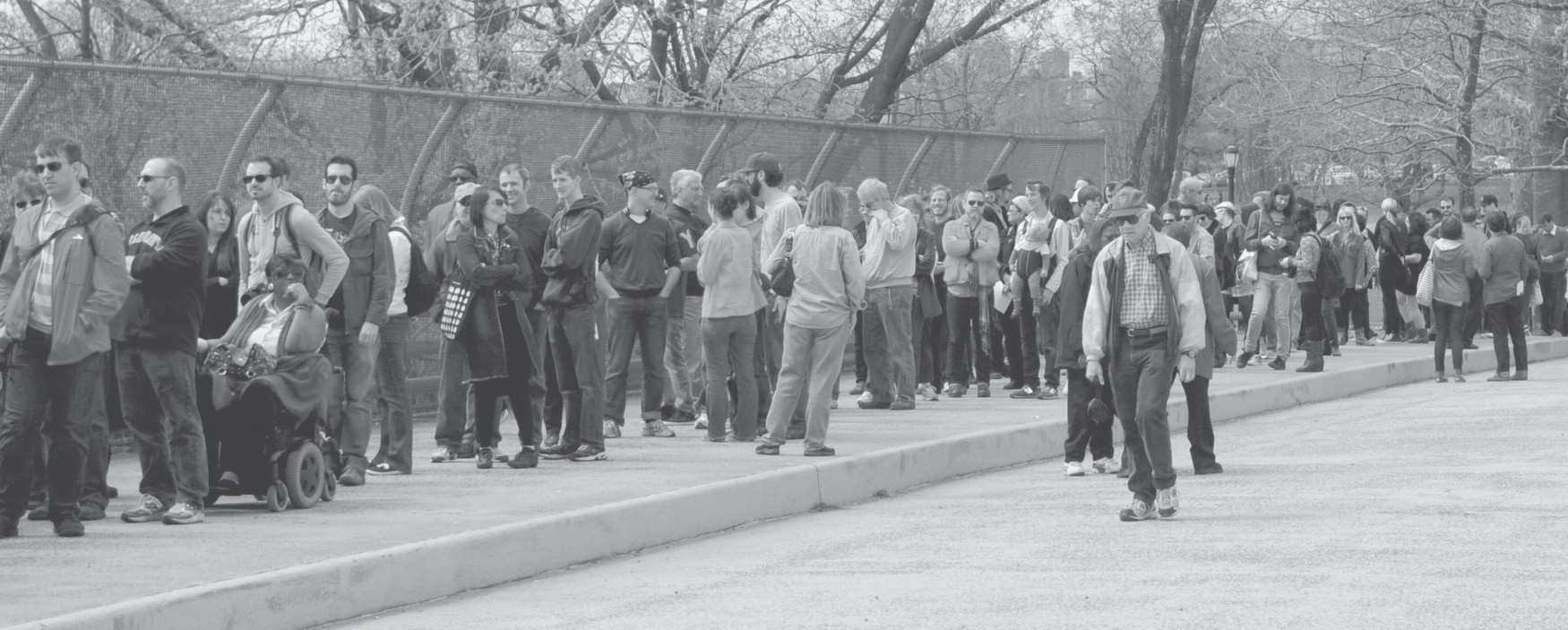Thousands Take Tour Of NY Pavilion
In the shadow of two iconic-if not weather-beaten- symbols of the 1964-65 World’s Fair, elected officials at Flushing Meadows-Corona Park formally kicked off last Tuesday morning, Apr. 22, Queens’ year-long commemoration of the exposition’s 50th anniversary.

The festivities began with the announcement that the New York State Pavilion-the futuristic structures which have virtually unused for much of the past 50 years-was named a “National Treasure” by the National Trust for Historic Preservation. It is one of only 44 sites nationwide deemed “historically, culturally and architecturally” important and deserving of such a designation.
The pavilion is also listed on the National Register of Historic Places.
Following a brief ceremony, the public got a chance to tour the pavilion’s “Tent of Tomorrow,” the elliptical steel space which once housed a massive terrazzo tile floor map of New York State.

Visitors donned hard hats as they viewed the interior of the facility, which is the focus of an ongoing restoration campaign spearheaded by Queens Borough President Melinda Katz and local preservationists.
Having been closed to the public for years, it seemed many history buffs, World’s Fair enthusiasts and curious spectators jumped at the opportunity to get a look inside the pavilion. Reportedly, the line stretched about three-tenths of a mile, from the pavilion entrance to the 111th Street parking lot.
“I am very pleased with the decision of the National Trust for Historic Preservation to select the New York State Pavilion to be one of its national treasures,” said Katz, who also serves as co-chair of the World’s Fair Anniversary Committee. “This designation is most appropriate given the pavilion’s distinctive architectural style and its connection to the excitement and hopefulness that captivated the world at the beginning of the Space Age.”
“This national treasure designation is wonderful news as we launch our commemoration of the two great fairs that took place here, said Assemblywoman Margaret Markey, the other World’s Fair Anniversary Committee co-chair. “It should also mean that we can be optimistic about the preservation and re-use of the entire iconic New York Pavilion just as other signature structures from those Fairs have become vital cultural organizations for Queens and New York City.”
“In the last 50 years, Flushing Meadows Corona Park has grown from the site of the World’s Fair to the home of the World’s Park,” added Queens Parks Commissioner Dorothy Lewandowski. “As we celebrate this anniversary, it is just as important that we look to the next 50 years and plan for the Park’s future. I would like to thank the National Trust for Historic Preservation for honoring the New York State Pavilion as a ‘National Treasure’. This designation will highlight the importance of the Pavilion as a national icon, and help us to continue the conversation about how it can best serve Queens’ residents.”
Among other officials on hand for the festivities include Rep. Joseph Crowley; State Sen. Toby Ann Stavisky; Assemblyman Jeffrion Aubry; City Council Majority Leader Jimmy Van Bramer; City Council Members Julissa Ferreras, Peter Koo and Mark Weprin; Flushing Meadows-Corona Park Administrator Janice Melnick; Director of Historic Preservation John Krawchuk; Stephanie Meeks and Paul Goldberger of the National Trust for Historic Preservation; and members of the New York State Pavilion Paint Project, a volunteer group that repainted Tent of Tomorrow’s multi-colored trim.
The New York State Pavilion consisted of four structures: the Tent of Tomorrow, three space-needle towers and the Theaterama, which later became the Queens Theatre in the Park.
Once adorned with a stained glass roof, the Tent of Tomorrow served as an exhibition space and dining area for guests. The needles-the tallest of which stands 226′-tall and served as an observation deck-also included a snack bar and gift shop.
While Theaterama was converted into the Queens Theatre after the fair closed, the pavilion’s remaining segments were left virtually unused in the years that followed. The Tent of Tomorrow’s stained glass roof was removed, leaving the roadmap tile floor exposed to the elements; in the decades since, much of the floor suffered significant weather damage.
Two floor panels restored through the work of the city’s Parks Department and the University of Pennsylvania were on display for visitors at last Tuesday’s pavilion tour.
The pavilion’s biggest claim to fame since the fair can be seen in the 1997 sci-fi movie Men in Black, during which it was made to humorously house alien aircraft.
Recently, the Parks Department indicated it could cost $40 million to preserve the structures as architectural elements and $50 million to preserve the pavilion while also restoring public uses. In March, Katz and the Queens Borough Board-comprised of the borough’s 14 community board chairpersons- requested funds in the next city budget toward restoration efforts.
Last Tuesday’s event was the first in a series of commemorations around the borough marking the 1964-65 fair’s golden jubilee. The exposition drew tens of millions of spectators to Flushing Meadows Park over two seasons, offering a variety of amusement rides, exhibits and other programs designed to promote the “Peace Through Understanding” theme while offering a glimpse of future advances.
The upcoming anniversary events include a May 18 “World’s Fair Anniversary Festival” at Flushing Meadows featuring an assortment of entertainment and exhibits of World’s Fair memorabilia from the 1964-65 expo and the 1939-40 World’s Fair, which marks its 75th anniversary this year. A live concert and a fireworks display will follow the festival.
For additional information on World’s Fair anniversary activities, visit www.itsinqueens.com/ worldsfair or www.nyc.gov/parks.


































